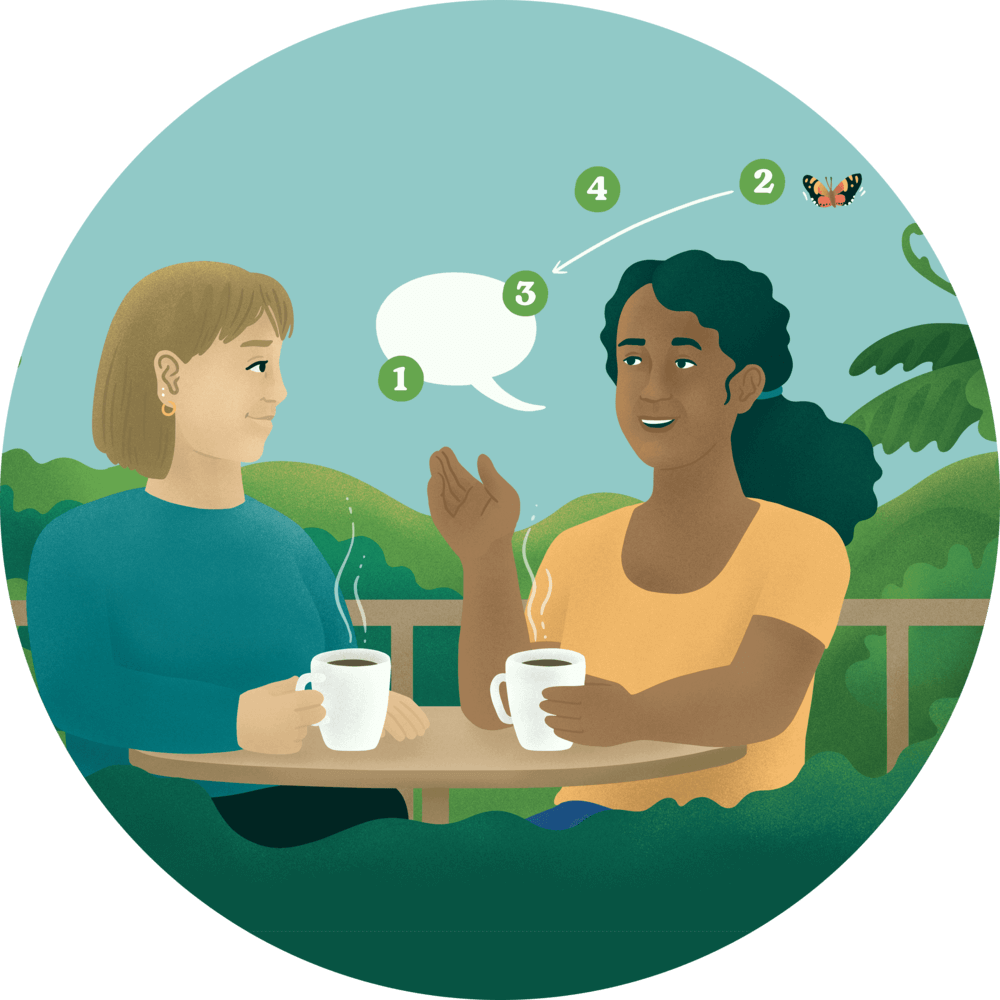
Active Listening
Active Listening is a meditation-like skill that involves fully concentrating on what a person is saying the entire time they are talking.

What is Active Listening?
Active Listening is a skill that involves fully concentrating on what a person is saying the entire time they are talking,
During our Active Listening exercise, you will practise listening to people speak about their lived experiences and pick up moments when you’re not paying attention.
How does it help?
Noticing when your mind wanders and bringing your attention back to listening helps you to listen and hear others. Active listening can help you respond to people in ways that make them feel understood, prevents you from interrupting them unnecessarily, and can improve your relationships with friends, partners, whānau, co-workers and other people in your life.

FAQs
What is selective listening?
It’s normal to get caught up in our thoughts sometimes when people are talking. You might start forming opinions about what they’re saying or thinking about how you are going to respond. Selective listening is when we only listen to some of what is being said and, as a result, can miss key details.
How can I further develop my listening skills?
The key is to apply active listening techniques in your everyday interactions. You won’t have a button to push when you become distracted by your mind, but you can say 'I’m not listening' to yourself. Then, let that thought go and calmly refocus on what the person is saying.
It may be helpful to summarise what they’ve said back to them, which shows that you were listening and gives them the opportunity to point out anything you’ve misheard or misunderstood.
What are some examples of Active Listening skills?
- Facing the speaker and maintaining an appropriate level of eye contact.
- Remaining neutral and non-judgmental in response to what they say.
- Being patient (periods of silence are not filled) - resisting interrupting and trying to impose ‘solutions’ or finish sentences for the speaker.
- Using verbal and non-verbal feedback to show signs of listening. For example, smiling, eye contact, leaning in, mirroring body language.
- Asking questions and listening to the answer attentively.

Try Active Listening now
Small Steps Toolbox
These tools have been developed to help with feelings of anxiety, stress, or low mood. Each tool only takes a few minutes. Health and wellbeing is an ongoing journey - so try them out and see what works for you.
Balancing Mood
This tool can give you insight into how what you’re doing affects your mood, and recommends activities that can improve how you’re feeling.
Understanding Loneliness
Loneliness is a common feeling we all get from time to time. The tool asks you when you feel lonely and gives insights on why or what you can do about it.
Mindful Watching
During this mindfulness exercise, you’ll be guided by relaxing audio to calmly notice different visual aspects of images and apply this to your surroundings.
Reframing Thoughts
This tool can help to identify unhelpful patterns in your thoughts and beliefs and reframe them over time to help you feel better and make decisions that support your overall sense of wellbeing.
Improving Sleep
Improving Sleep is a quiz that helps you explore the things you can do or avoid that can lead to a better quality sleep. There are a variety of tips available so you can choose something that suits your lifestyle.
Identifying Signals
During this exercise, you’ll be guided to identify sensations in your body that you often experience when feeling upset. You can use these as signals to react differently, use a tool, or engage in self-care.
Supporting Others
Supporting Others gives you tips on what you can say or do when you’re helping someone who’s going through a hard time.
Gratitude Practice
Learn to appreciate the small things in life through practising gratitude. Doing this regularly can help lift your mood and make you feel happier.
Muscle Relaxation
Teach your body how to relax better through muscle relaxation. The key is learning to apply this skill in everyday life to the entire body so that you’re not tensing muscles when you don’t need to.
Deep Breathing
This reflective technique involves slowly breathing in and out to help you feel calmer and more relaxed. This tool is guided by an animated image that inflates and deflates.
Building Self-Worth
This tool helps you on your journey to gain self-worth. Go through the Building Self-Worth card deck for energetic, reflective, or inspirational activities.
